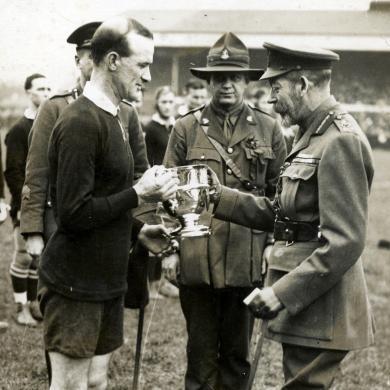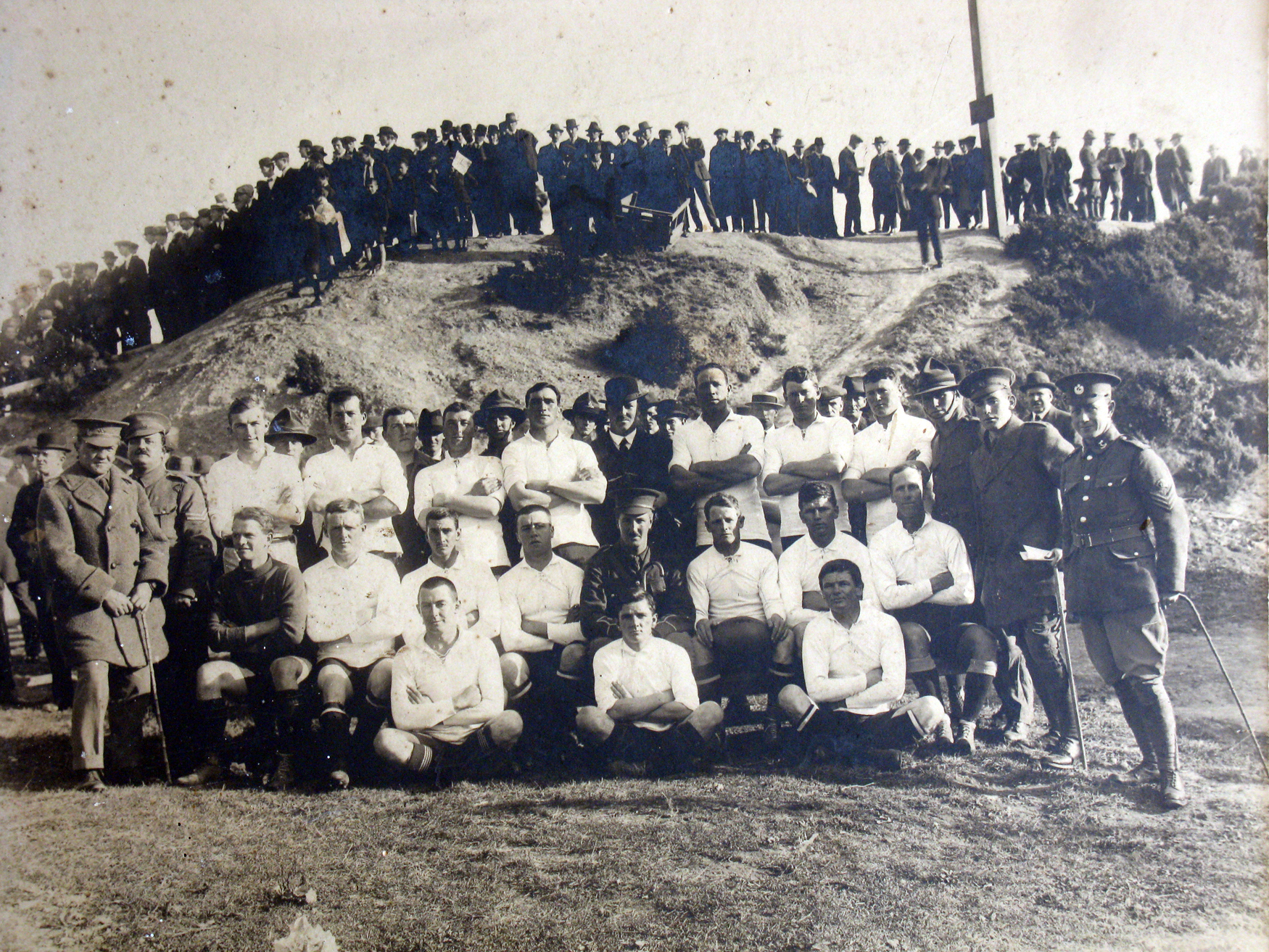Did you know that the First World War servicemen of the British Empire staged the first international rugby tournament in 1919?

King George V presenting the King’s Cup to the captain of the New Zealand Services Rugby Team in 1919. Courtesy of NZ Rugby Museum.
Throughout the First World War – both in New Zealand and abroad – rugby was one of several sporting activities encouraged by senior officers as a variation from the troops’ repetitious military training and drills. Rugby was played not only to maintain fitness but it also contributed towards team spirit within the military’s units.
Following the Armistice in November 1918, hundreds of thousands of servicemen from across the British Empire spent the early months of 1919 waiting for ships to return them home from England. During this time a rugby competition was arranged between the forces from New Zealand, Australia, South Africa, Canada, England (named Mother Country), and Royal Air Force. A high percentage of New Zealand’s amateur rugby union players had served in the First World War, so it is little wonder that the New Zealand Services team won the tournament.
The 1919 Inter-Services tournament (also known as the King’s Cup tournament) was the first international rugby event involving several representative teams from the northern and southern hemispheres. It sowed the seed for a future Rugby World Cup, although it took over 60 years for that seed to germinate when the International Rugby Board finally approved an international rugby tournament in the 1980s.

The 1915 Trentham Army Camp rugby team. Image courtesy of the New Zealand Rugby Museum.
During the 1915 season, the Trentham Military Camp contributed four teams in the Wellington club competition. From these teams a Trentham representative team was chosen, which comfortably defeated both of the Wellington and Auckland provincial sides. This was not surprising as Trentham fielded seven All Blacks. By 1915 the cream of New Zealand’s pre-war rugby talent were no longer playing in their provincial teams – many had enlisted early on in the war, and were either already serving at Gallipoli or about to land there.
At the New Zealand military training camps in Egypt – first at Zeitoun and later Ismailia – games were played between the various units of the New Zealand Expeditionary Force. These games were not friendly social occasions, as was often the norm when played by Englishmen. Instead they became an extension of provincial rivalry. The Otago Battalion and Wellington Battalion would battle it out in the hot desert sand, which was a change from the heavy muddy grounds of Athletic Park or Carisbrook. Players and spectators wrote home to their families boasting of their unit’s victory.
Even within battalions there were rugby games between platoons, one such game being fought over a day’s ration of jam! ‘Canterbury Infantryman’ wrote home after witnessing a game. ‘No. 3 and 4 platoons tried conclusions in a most exciting game. The stake was a day’s ration of jam and the teams, therefore, took the game very seriously. It was as wild as one could possibly wish for, and there were no “beg pardons.” No.4 won by a penalty goal to nil, but play was very even…. No. 3, in consequence, had no jam today, but they are in hopes of getting a double ration at a future date.’

A scrum between officers of the Canterbury Mounted Rifles and Wellington Mounted Rifles somewhere in the Middle East. Image courtesy of the AF Batchelar Album, Palmerston North City Library Photograph Collection.
There were no opportunities for rugby at Gallipoli, but at the base camp on Lemnos several games were played among the fresh reinforcements from New Zealand. The most notable was a trans-Tasman contest among the ANZACs played on a sandy beach at low tide. The New Zealanders fielded a team containing three All Blacks and defeated Australia 13 tries to nil – no goals being kicked because there were no goalposts. A few days later the teams were fighting alongside each other on Gallipoli.
After the Gallipoli campaign, rugby resumed in Egypt and when the main force departed for France the units which remained to serve in Sinai and Palestine continued with games. The Auckland Mounted Rifles were particularly strong and lost only two of their 36 games during the war. Early in 1919 a tournament took place at Ismailia involving five Australian teams, four British, and one New Zealand team. The New Zealand Mounted Rifles team won the competition and was awarded the Moascar Cup. The trophy was brought home, and since 1920 has been used for competition among New Zealand secondary schools.
New Zealanders also dominated rugby matches played in England and France during the war. A team, drawn from the New Zealand Division on the Western Front and known as the Trench All Blacks, won the Somme Cup against teams representing other Allied divisions in the region in 1917. Units based in England were popular and attracted good crowds, the proceeds from the gates going towards the war effort. Any game against a Welsh team was particularly rugged as the New Zealanders were seeking revenge for the All Blacks’ loss to Wales back in 1905.

The New Zealand Trench All Blacks, 1917. Image courtesy of the New Zealand Rugby Museum.
In 1919, following the New Zealand Services team’s victory in the King’s Cup in England, they visited South Africa on a popular 15-match tour. That tour resulted in the commencement of regular exchange tours between national teams of the two countries from 1921.
The Maori (Pioneer) Battalion also made a major contribution to wartime rugby with games in France and England. When the battalion returned home in 1919 a team toured the provinces playing nine games and helped revive provincial rugby after years of limited activity during the war.
As players or administrators, it was largely ex-servicemen who led New Zealand rugby into the golden era of the 1920s. One third of the 1924/25 Invincibles All Blacks team that toured Britain had served in the war.

King George V presenting the King’s Cup to James Ryan, captain of the New Zealand Services Rugby Team, after the team's win in the Inter-Services Tournament at Twickenham rugby ground, London in 1919. Image courtesy of the New Zealand Rugby Museum.
Nearly 800 provincial rugby representatives, including 50 All Blacks, left New Zealand to serve in the First World War. 42 servicemen gained All Blacks honours after the war. Tens of thousands of club players served. 163 of New Zealand’s provincial representatives, including the great All Blacks captain Dave Gallaher, died from wounds or sickness during the war. Many more returned home in a physical condition that prevented any further sports participation. But there were also the many returning fit servicemen whose appetite for rugby had been fuelled by watching or playing in the wartime games. The comradeship and discipline, developed during their army service, motivated them to actively pursue the national game over the following winters.
The New Zealand Rugby Museum has mounted Balls, Bullets and Boots, an exhibition that will travel around the country during the First World War centenary period. The exhibition, currently in Palmerston North, is based on the book of the same name, also produced by the museum. The display features rugby players and their involvement in the war.